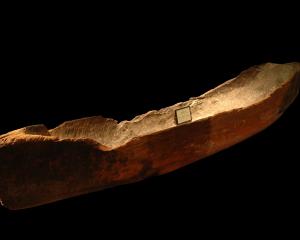Thomas Hocken had a passion for collecting that has left many in his debt. Donald Kerr, author of a new book dissecting that curiosity, discusses vision and tenacity with Shane Gilchrist.
An influential figure in the cultural fabric of early Dunedin, Thomas Morland Hocken might have stood only about 4ft 8inches (142cm), yet the breadth of his passion for collecting is still being measured more than a century after his death.
Hocken was the right man at the right time, according to author Donald Kerr, who has completed an exhaustive examination of the ''wee doctor's'' passion for collecting books, pamphlets, newspapers, manuscripts, maps, paintings and photographs relating to New Zealand and the Pacific.
In Hocken: Prince of Collectors (Otago University Press), Kerr describes Hocken's foresight and tenacity in salvaging historical documents and books relating to New Zealand at a time when such material was not being preserved by institutions.
''Hocken had vision. He came here and realised New Zealand did have its own antiquities and they were worth salvaging, and he was the man to save them,'' says Kerr, who points out that, in documenting history, Hocken has also become part of it.
Kerr, special collections librarian at the University of Otago, describes Hocken as one of the ''Holy Trinity'' of early book collectors in New Zealand, the others being Sir George Grey and Alexander Turnbull.
In her foreword to Prince of Collectors, Hocken librarian Sharon Dell, who has also worked at the Alexander Turnbull Library, notes there are significant differences in the collections of each.
''Turnbull was interested in books as objects,'' Dell writes.
In contrast, Hocken's approach to collecting was both idiosyncratic and practical; he developed his collection as a database for his own research and public lectures.
The result: 5200 books, hundreds of manuscripts, 34 volumes of ''Variae'' (650 disparate manuscripts and ephemeral printed materials bound together), 17 volumes of ''Flotsam and Jetsam'', 2800 pamphlets in 201 volumes, maps, sketches, paintings and photographs.
As Kerr notes in a chapter on Hocken's legacy, some 30,000 items from his collection are used in the Hocken Library's reading rooms each year; 9000 people access the collections on site, its users split into three broad categories (a third are from the University of Otago and Otago Polytechnic; a third are family and local historians; and the remainder independent researchers and academics from further afield).
Hocken's collection of material relating to the Rev Samuel Marsden and the Church Missionary Society (including The Letters and Journal of Samuel Marsden, was inscribed on the New Zealand Register of the Unesco Memory of the World programme last year.
Last year also marked the launch of the Marsden Online Archive, which comprises thousands of pages relating to the manuscript letters and journals in Hocken's collection, along with transcripts and online research tools.
As Prince of Collectors notes, more than a century after their acquisition and, in some cases, 200 years after the events they describe, the records of the foundations of New Zealand are accessible anywhere in the world.
Therefore, there is a currency to the words ''open to the public'', used when Otago Museum's Hocken Wing, then home to the collection, was officially inaugurated on March 31, 1910.
His health failing, Hocken was too ill to attend that ceremony.
He died on May 17, 1910, of cancer of the oesophagus. He was 74.
• Kerr describes Hocken: Prince of Collectors as the first specific and systematic account of Hocken as a book collector.
That's not to diminish the work of others: Kerr acknowledges Eric McCormick's 1961 essay Fascinating Folly; A. G. Hocken's 1986 lecture Dr T. M. Hocken 1836-1910: A gentleman of his time and his more recent Dr Hocken of Dunedin: A life (2008); as well as John Ross' 1997 article on Hocken in the Dictionary of Literary Biography.
More recently, Ka Taoka Hakena: Treasures of the Hocken Collections (Otago University Press, 2007), documents almost 200 items, dating from the 17th century to the present day.
''I have a fear a lot of people know about Hocken. There has been so much written about him,'' Kerr says, adding he hopes new and relatively unknown facts about Hocken's collecting habits will form a more rounded picture and understanding of him.
''I was lucky in that I wasn't writing a thematic piece or a hypothesis.
''I was guided by his life and the things that happened to him, both as a man and a collector.
''The end product is much smaller than what I had amassed. I have all this data but I haven't used it. There's just so much ... I'm going to deposit an unedited version at the Hocken.''
Kerr adopted what he calls a ''bio-bibliographical'' approach, covering the types of material Hocken collected; the process and context of how Hocken acquired his material; the development of Hocken's library within New Zealand and, to some extent, Australia; Hocken's various publications; and, lastly, Hocken's life and personality.
Granted six months' leave from the University of Otago Library in 2007, Kerr physically examined every volume in the original Hocken collection, pored over correspondence in libraries and archives and visited various locations and institutions in his research.
A Ministry of Heritage and Culture Award (2007) and a Winston Churchill Memorial Award (2010) also helped greatly, as did the many people who matched Kerr's enthusiasm for the project.
''Without input from them (his list of acknowledgements is long), the book would be a lesser being. It is very true that we stand on the shoulders of others, and their work.''
The Churchill award allowed Kerr to travel to the United Kingdom and find out more about Hocken's early life.
Born in Stamford, Lincolnshire (about 150km north of London), Hocken and his siblings led a transient life; his father, Joshua, a Methodist circuit preacher, was required to relocate every three or four years.
Hocken, too, moved around as he sought to bolster his knowledge of medicine.
Thus his trail took Kerr to Leeds, London, Newcastle and Dublin, all of which were home to institutions attended by the young medical student before he took on a job in 1860 as surgeon-superintendent on board SS Great Britain, one of the many emigrant ships ploughing a route between Britain and Australia.
It was on board SS Great Britain that Hocken's then fledgling habit of securing printed materials gained impetus.
He saved an 1861 reprinted version of the ship's newspaper, the Great Britain Magazine and Weekly Screw, which included Hocken's first published writings.
Kept as a treasured family item by Hocken's only child, Gladys, until she donated it to the SS Great Britain archives in Bristol, England, where it was discovered by Kerr, the newspaper features Hocken's initials or signature, used to indicate his various contributions, which ranged from essays on seasickness, to the ship and her inhabitants, to ''A story of un-true [sic] love''.
Having spent a year as surgeon aboard the ship (and a month in Melbourne), a 26-year-old Hocken landed in Dunedin on February 22, 1862, joining the rush of people seeking their fortune following Gabriel Read's discovery of gold in the Tuapeka district the previous year.
• Although, Kerr writes, ''there is a paucity of information about Hocken's first year in Dunedin'', clearly he had ambitions.
By February 1863, he had been appointed Dunedin's coroner, a position that gave him both money and the social standing to cultivate a network of contacts.
''He was always asking people, in letters, to send him stuff they might have had lying around. He'd doggedly travel around New Zealand picking up stuff. He also made trips overseas.''
The first recorded item Hocken accepted into his collection and, importantly, the first result of his many requests for material on early New Zealand history, was titled On Maori habits of life.
Given to Hocken in 1864 by German missionary Johann Riemenscheider, On Maori habits of life is described as a closely packed essay of 33 leaves covering such subjects as venereal disease, measles, the use of tobacco, asthma and skin diseases.
It also features annotations by Hocken, setting a precedent for many future scribblings of details.
As he once remarked, ''Dates are dry, but imperative''.
A highly individualistic activity, collecting has been defined by one academic as ''an unruly passion''.
Certainly, Hocken's collection - and, significantly, the means by which he came about his material - provides an insight into the man's personality.
''He locked into certain fields of interest,'' Kerr says, referring to Hocken's initial collecting, much of which focused on the early discovery narratives of James Cook; the writings of the Rev Marsden and his contemporaries; Edward Gibbon Wakefield and the New Zealand Company; and Maori, especially in the South.
''He made a statement by his interest in Marsden, Wakefield and the New Zealand Company.
''I think he was fortunate to pick up on those areas of interest at a time when the kith and kin of those people were still alive and wondering what to do with the documents they had.
''We are lucky in that Hocken compiled a working library. He was a great educator and promoter, giving lectures throughout the country on subjects researched through documents and books he had collected.
''He had stuff published and, in working with his material, he documented it. He left a journal of his travels up and down the country and where he picked up material.''
One of his frequent trips to the North Island led the dogged doctor to the Maori settlement of Parihaka where, in February 1881, he met prophet and pacifist Te Whiti, whom Hocken described in his journals as, ''about 45 with straight black hair striated with grey - said not a word though frequently caught him looking at me when he thought I was engaged with the others - not exactly sullen but reserved and apparently thoughtful''.
(In November that year, government forces invaded Parihaka, arrested Te Whiti and fellow prophet Tohu Kakahi and almost wiped out the peaceful settlement.)
Later, in 1908, the same curiosity took Hocken to the basement of a Government building in Wellington where he unearthed a ''damaged and rat-eaten'' Treaty of Waitangi from among a pile of documents.
''I think we are very fortunate,'' Kerr says.
''Some of his treasures are not like Shakespeare folios or medieval manuscripts. They are shabby bits of paper.''
Still making the list
Thomas Hocken's A Bibliography of the Literature Relating to New Zealand, published in 1909, was the pinnacle of his career, according to Donald Kerr, author of Hocken: Prince of Collectors.
''An extraordinary piece of work'', Hocken's 632-page Bibliography was published in July 1909, its title page featuring a Maori motto: ''He mahi nui rawa atu'', which he translated as, ''Truly, this is a very laborious deed''.
The longest review of what was described as an ''indispensable volume'' appeared in the Otago Witness on August 18, 1909, when an anonymous reviewer praised ''this veritable treasure-house of knowledge''.
A Bibliography of the Literature Relating to New Zealand endured for 60 years as the principal record of New Zealand publications.
As Kerr notes: ''Even now it has an important position in New Zealand letters, holding bibliographical and scholarly value despite Graham Bagnall's six-volume New Zealand National Bibliography to the Year 1960 (1969-80) and the onslaught of computerised systems such as the National Library-driven Te Puna database.
''It remains a very useful book for librarians, book historians and book dealers. Indeed, an 'In Hocken' or 'Not in Hocken' reference still carries weight in many book dealer catalogues.''












